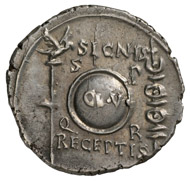Human Faces Part 12: Augustus, Peacemaking Emperor or Mass Murderer?
with the kind permission of the MoneyMuseum, Zurich.
Why is it that for centuries – or rather thousands of years – the head has served as the motif for the side of a coin? And why has this changed in the last 200 years? This chapter of the series ‘Human Faces’ looks at Augustus and his new image following the Civil War.
The imagery of the so-called Augustus of Primaporta recalls the recovery of the lost battle standards and commemorates the triumphant peacemaking ruler. Vatican Museums, Rome. Photo: Till Niermann. http://creativecommons.org/licenses/by-sa/3.0/deed.en
We know Augustus as Caesar’s heir, who, after long and arduous struggles, ended the Civil War. His contemporaries, however, saw him very differently. To them, he was the butcher of the Republic who, together with Mark Antony, plotted the proscriptions. Rome’s most important politicians – including Cicero – fell victim to these proscriptions. Augustus expelled thousands of farmers from Italy so that he might settle his veterans on their land. He prolonged the civil war for many years, solely to gain autocratic rule. And with the victory over Marcus Antonius, he succeeded. From that point on, he was the most powerful person in Rome; and now it was time to change his image.
Roman Imperial Era. Augustus (27 BC-14 AD). Denarius, Cologne, 19 BC. Head of Augustus in idealized form facing right. Rev. Clupeus Virtutis (see text), to the left, eagle, and to the right, battle standards. © MoneyMuseum, Zurich.
And Augustus did an admirably thorough job doing so; All public buildings, every statue, every coin – they all served only to venerate his virtues. His obedience to the traditional, his military competence, his munificence and the fact that the Gods loved and protected him were all glorified, including here, on the depicted coin. Augustus styled himself as a ‘Übermensch.’ In images, he never grew older. On coins that were minted during the time of his autocratic rule, his portrait was reminiscent of the classical busts of the God Apollo.
On the reverse of the coin, we see the Clupeus Virtutis, a golden shield awarded to Augustus by the Senate for the imperial ‘Virtus.’ To a Roman, Virtus encompassed all the attributes that a man (lat. vir) must possess in order to please the Gods. Included among them was ‘Pietas,’ the willingness to respect and adhere to all traditional laws and customs, as well as military prowess. If a man was in possession of these, he was a favourite of the Gods and, hence, had success. And, by the same token: Whoever had success was clearly in possession of Virtus, or the Gods would not have bestowed victory upon him. And the coin conveys exactly this sentiment: It combines Augustus’ greatest diplomatic achievement, the return of the battle standards lost by Crassus to the Parthians, with the imperial Virtus. For contemporaries, the message was this: ‘As our emperor has at his disposal an abundance of Virtus, the Gods have bestowed victory upon him, and the imperial Virtus ensures this continued godly protection.’
Augustus had the great fortune of having outlived most of those who witnessed the civil war. And so, their descendants knew him solely by the image he had been trying to hammer home for decades: as the great peacemaking emperor.
In the next chapter, you’ll learn how Nero brought attention to and celebrated his single foreign policy achievement on coins.
All sections of the series can be found here.
The book ‘MenschenGesichter’ is available in printed form from the Conzett Verlag website. It soon will be translated to English. It soon will be translated to English …











